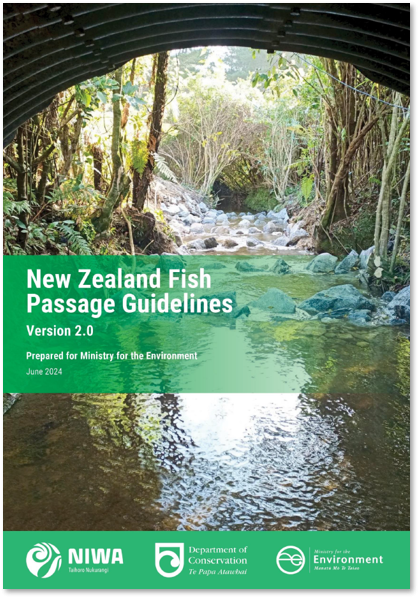Recommended standards for the design and restoration of instream infrastructure to provide for fish passage

Contents
- Introduction
- Legislative context and requirements
- Fish passage objectives and performance standards
- Design of new and replacement instream structures
- Fish passage remediation at existing structures
- Exclusion barriers: a special case for protecting native biodiversity
- Fish passage at dams
- Monitoring fish passage success
These guidelines have been developed to assist infrastructure designers and managers, waterway managers, environmental officers, iwi and local communities with understanding and promoting better management of fish passage requirements in New Zealand. The guidelines set out best-practice approaches and design standards for providing fish passage at instream structures based on current best available evidence. The general principles of good fish passage design set out in these guidelines should provide a basis for developing suitable infrastructure designs in the majority of situations regularly encountered in New Zealand.
The guidelines are based on the principle that good fish passage design achieves the following general objectives:
- Efficient and safe upstream and downstream passage of all aquatic organisms and life stages resident in a waterway with minimal delay or injury.
- A diversity of physical and hydraulic conditions are provided leading to a high diversity of passage opportunities.
- The structure provides no greater impediment to fish movements than adjacent stream reaches.
- Continuity of geomorphic processes such as the movement of sediment and debris.
- Structures have minimal maintenance requirements and are durable.
Our second edition (June 2024) guidelines have been expanded to include new sections on providing for fish passage at dams, flood pumping stations and examples of te ao Māori perspectives.
Updates have been made to the sections on:
- Legislation
- Fish passage objectives and performance standards
- Design guidelines for new culverts
- Tide and flood gate design and remediation
- Remediation of existing structures
- Monitoring the effectiveness of fish passage remediation.
Acknowledgements
Development of the New Zealand Fish Passage Guidelines was initially funded by contributions from the Ministry for Business, Innovation and Employment (contracts C01X1002, C01X1524 and C01X1615), the Department of Conservation, Environment Canterbury, Fish and Game New Zealand, Greater Wellington Regional Council, Horizons Regional Council, Otago Regional Council, Northland Regional Council, Tasman District Council and Waikato Regional Council. The 2024 revisions to the Guidelines were funded by the Ministry for the Environment.

